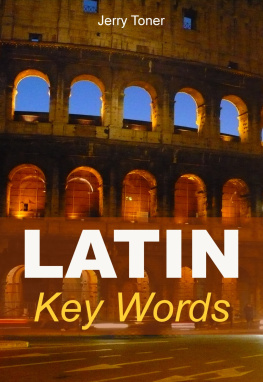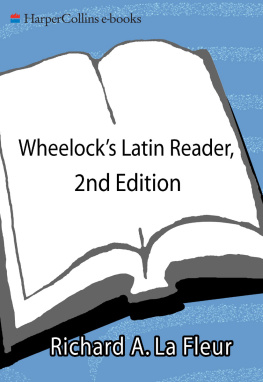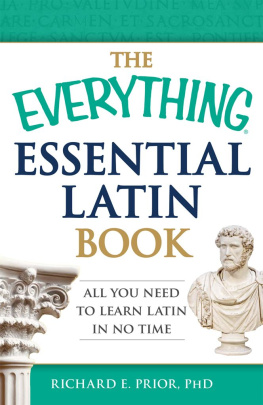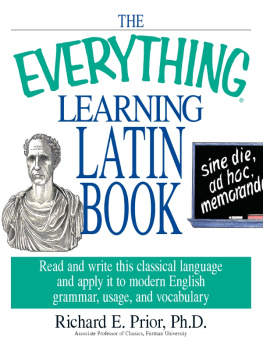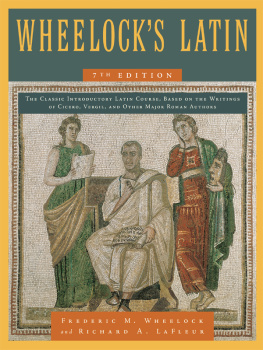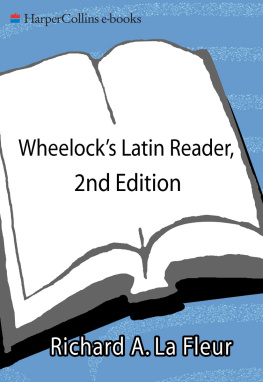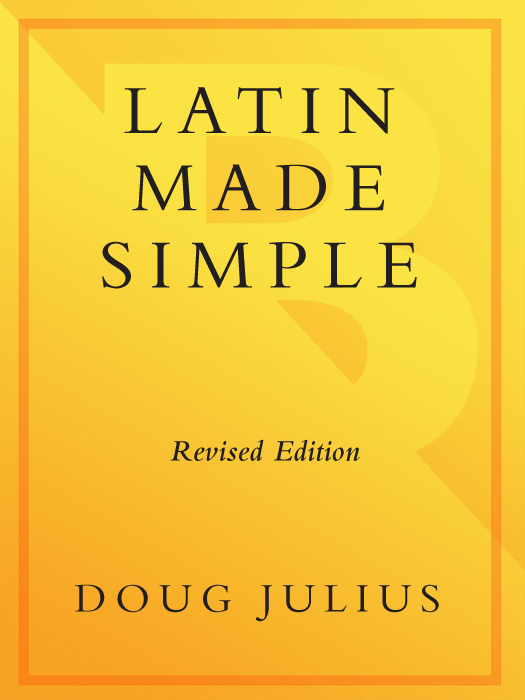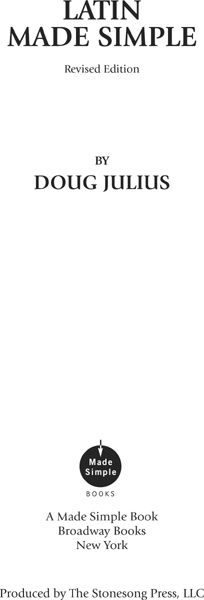CONTENTS
Latin and EnglishWord DerivationThe Parts of SpeechInflectionThe AlphabetPronunciationSyllablesAccentUsing the Dictionary
CHAPTER 1
First Declension NounsVerb ConjugationsFirst ConjugationPresent Active IndicativeAdjectivessum, esseRoman NumeralsNoun CasesReviewReading
Boxes: Some Womens Names of Latin Origin and Their MeaningsThe Signs of the ZodiacThe PlanetsFamiliar PhrasesFamiliar QuotationsWord Derivation
CHAPTER 2
Second Declension NounsNeuter NounsFirst and Second Declension AdjectivesSecond Conjugation VerbsImperfect Active IndicativePossessive AdjectivesReviewReading
Boxes: Familiar QuotationsSome Mens Names of Latin Origin and Their MeaningsPrefixesLatin on Tombstones and Monuments
CHAPTER 3
Eo, cum (Preposition and Conjunction)Future TenseImperativesReviewReading
Boxes: Familiar PhrasesState MottoesLegal TermsFamiliar Quotations
CHAPTER 4
Passive VoiceThird Declension NounsThird Declension i-stem nounsPrincipal PartsReviewReading
Boxes: Familiar PhrasesSuffixesChemical ElementsAdditional Prefixes
CHAPTER 5
Perfect Active TensesPerfect Passive TensesTime and Place CuesCardinal and Ordinal Numbersvolo, nolo and maloNegative ImperativesThird Conjugation Verbsis, ea, idReviewReading
Boxes: Familiar AbbreviationsFamiliar PhrasesAcademic Degrees and Terms
CHAPTER 6
Third Conjugation i-stem Verbsfero, ferrehic, ille, ipse and idemComplementary Infinitivefio, fieriThird Declension AdjectivesInterrogative PronounPresent Passive InfinitiveReviewReading
Boxes: Latin Phrases Used in the Constitution of the United StatesPronunciation of Church LatinFamiliar Quotations
CHAPTER 7
Fourth Conjugation VerbsRelative Pronouns and Relative ClausesInterrogative Adjective and PronounDeponent and Semi-Deponent VerbsFourth Declension NounsFifth Declension
NounsPersonal PronounsPossessive AdjectivesReflexive PronounsReviewReading
Boxes: Familiar PhrasesFamiliar Abbreviations Legal Terms
CHAPTER 8
Cardinal and Ordinal NumbersComparative AdjectivesSuperlative AdjectivesComparisonsComparative and Superlative AdverbsReviewReading
Boxes: More State MottoesFamiliar QuotationsMathematical Terms Derived from LatinGeometrical Terms Derived from Latin
CHAPTER 9
InfinitivesIndirect StatementParticiplesAblative AbsolutesThe Gerundive and the GerundReviewReading
Boxes: Medical Abbreviations Derived from LatinFamiliar AbbreviationsFamiliar Quotations
CHAPTER 10
The Subjunctive MoodSequence of TensesJussive and Hortatory SubjunctivePurpose ClausesResult ClausesNoun ClausesRelative
Clauses of CharacteristicOptative Subjunctivecum ClausesConditional SentencesConcessive ClausesReviewReading
Boxes: Church HoursThe Months of the YearSpecial Days in the Roman MonthsAn Overview of Latin Literature
PREFACE
About This Book
Although a classical language, Latin is far from deadlinguists use that term merely to define a language that has no native speakers. Latin is very much vital and living. It is a pillar of our own language, our culture, and our civilization. Latin is a thread that connects us with our own history; if it were to snap, we would lose our relationship to the past.
Fortunately, more and more people are discovering the importance and rewards of learning Latin. We are witnessing a major revivalone that seems likely to continue. As Latin is no longer a spoken language, todays students are interested primarily in being able to read Latin, for pleasure and profit, with reasonable facility and comprehension. Latin Made Simple was conceived, organized, and written to help achieve this objective.
The book presents Latin grammar with economy and clarity, and this alone makes it valuable to the reader and student. Of even greater value is the books focus on the practical reading requirements of non-specialists. We have tried to anticipate your questions, divine your needs, and respond to your most likely interests and concerns.
This newest edition adds a number of reference features that make Latin Made Simple not only an excellent self-guided tutorial, which it has always been, but a useful tool for review and for expanding ones command of the language beyond the beginning stages.
Each chapter introduces a number of new grammatical concepts that should be mastered before proceeding to the learning a language is a cumulative experience. These sections are numbered, in this edition, in order to facilitate use of the index to which they are keyed. Each chapter is organized to introduce (1) new reading vocabulary, (2) new morphology (the shapes of the words), (3) new syntax (rules for constructing sentences), and (4) exercises to work through (with an answer key in the back) to ensure command of the new material covered. Each chapter, lastly, ends with a review of the material covered in the chapter and a reading, in Latin, to test your progress before moving on.
Latin Made Simple is for the readers and students who want to read the rich treasury of Latin literature, history, law, and religion in the originalsince all translations have their failings. The rewards are many and include understanding of innumerable ways in which Latin has nourished and enriched English and become woven into contemporary life. Our coins and bills, the legend on school diplomas, language on medical prescriptions, and scores of words and phrases we use unconsciously every day all reflect the continuing vitality of Latin. Latin Made Simple is intended for the lively minded and curious, in school or no longer in school, who want to know more about a language and a culture that have done much to shape our own.
Brief History of Latin
Latin was one of the many languages spoken in Italy before 200 B.C. Over the next century, it became the common dialect of the peninsula and developed into a literary language as well as a spoken one. This we call Classical Latin.
As the Roman Empire expanded, dialects of Latin developed, some giving rise to the Romance languagesRomanian, Italian, Spanish, French, and Portuguese.
One dialect, known as Medieval Latin, was used in the Middle Ages both as a spoken trade language and as a written language. Though extremely similar to Classical Latin, Medieval Latin dispensed with some of the more complex constructions of Classical Latin. Thus, if you learn Classical Latin, you can read Medieval Latin as well.
Until quite recently, the Catholic liturgy used spoken Latin, and today, many churches are attempting to revive its use.
It is unfortunate that Latin is often referred to as a dead language. It is true that no one speaks Latin as his or her first language, but not that Latin is not used, spoken, or useful in todays world. Written Latin never died. Renaissance scholars used it, and today scientists draw new words from itmany of the chemical elements have Latin names. Lawyers and doctors also draw on Latin, and in this book you will learn some of the phrases that they have borrowed.
1. Latin and English
English is not derived from Latin in the same way as the Romance languages named above. Rather, English comes from Anglo-Saxon, a Germanic language. Germanic is a cognate language, containing words derived from both languages. Germanic and Latin stem from the same parent language, a reconstructed language known as Indo-European.


